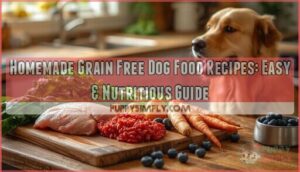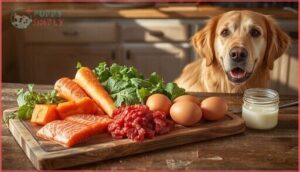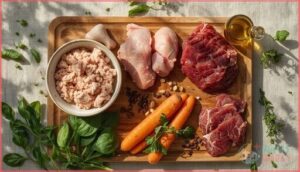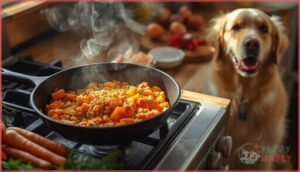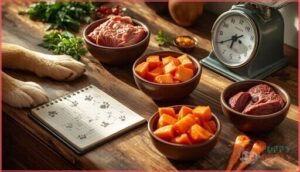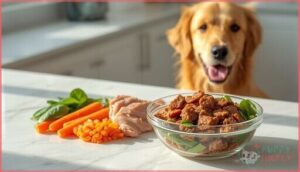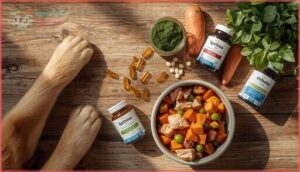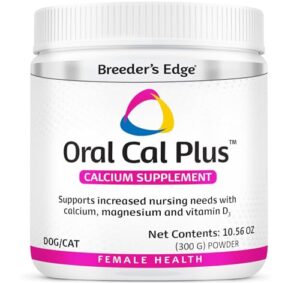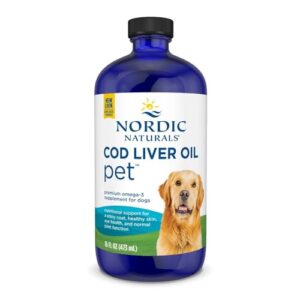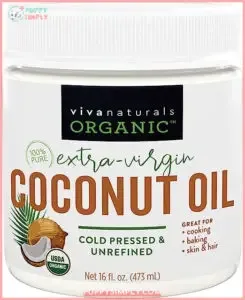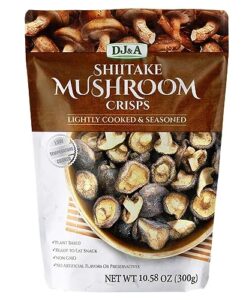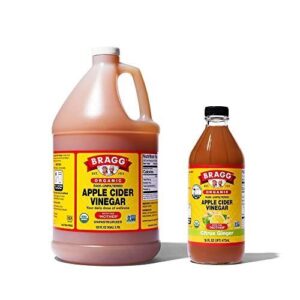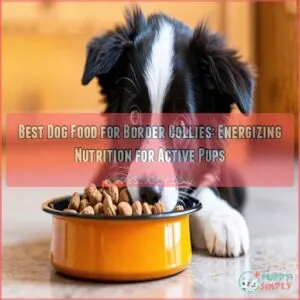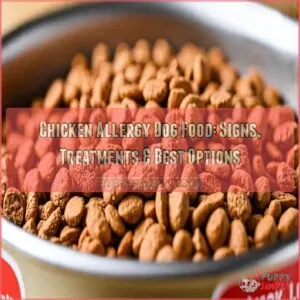This site is supported by our readers. We may earn a commission, at no cost to you, if you purchase through links.
Your dog’s health starts in the kitchen, not just at the vet’s office. When commercial dog foods trigger allergic reactions, digestive issues, or unexplained itching, many pet owners feel trapped between expensive specialty brands and watching their dogs suffer.
Making your own grain-free dog food gives you complete control over what goes into your dog’s bowl, eliminating common allergens like wheat, corn, and soy while ensuring every ingredient has a nutritional purpose.
The best part? You don’t need culinary skills or fancy equipment—just quality proteins, the right vegetables, and a basic understanding of canine nutrition to create meals that support your dog’s health from the inside out.
Table Of Contents
- Key Takeaways
- Benefits of Homemade Grain-Free Dog Food
- Essential Nutrients for Grain-Free Dog Diets
- Simple Grain-Free Dog Food Recipes
- Preparation, Storage, and Serving Tips
- Supplementing Homemade Grain-Free Dog Food
- Top 5 Products to Enhance Grain-Free Dog Food
- Frequently Asked Questions (FAQs)
- Why do vets not like grain-free dog food?
- What ingredients should be in homemade dog food?
- What can I add to my dog’s grain-free food?
- What is a good filler for homemade dog food?
- How do I know if my dog needs grain-free food?
- Can I add supplements?
- How do I transition my dog?
- What grains should I avoid?
- What are the best vegetables?
- How often should I feed homemade grain-free food?
- Conclusion
Key Takeaways
- Homemade grain-free dog food gives you complete control over ingredients, which helps eliminate common allergens and supports dogs with food sensitivities, though true grain allergies affect less than 1% of dogs—most reactions stem from proteins like beef and chicken.
- You’ll need to carefully balance protein (around 70% meat), healthy fats (like fish oil for omega-3s), vegetables (2-10% for fiber), and essential supplements (especially calcium, as 90.9% of homemade diets lack adequate selenium and many have calcium-phosphorus imbalances) to meet AAFCO nutritional standards.
- Proper food handling matters—batch cook for convenience, store meals in the fridge for only 3-4 days or freeze for 2-3 months, thaw safely in the refrigerator, and weigh portions on a kitchen scale since measuring cups can lead to 80% overfeeding.
- Always consult your veterinarian before switching to homemade grain-free recipes, especially regarding supplement dosing and nutritional balance, because even well-intentioned homemade diets often fall short on critical nutrients like vitamin D, calcium, and zinc without professional guidance.
Benefits of Homemade Grain-Free Dog Food
Making your dog’s food at home gives you a say in what goes into their bowl, and going grain-free can address specific health concerns your vet has flagged. Some dogs respond well to these diets, showing fewer allergy symptoms and better digestion.
Here’s what you might notice when you switch to homemade grain-free meals.
Reduced Allergies and Sensitivities
When your dog scratches constantly or develops red, irritated skin, food sensitivities might be the culprit. While food allergy prevalence affects only 1–2% of all dogs, protein allergens like beef and chicken cause most reactions—not grains. Still, grain-free diets for dogs can help if your pup is gluten-sensitive or allergic to wheat. A diet elimination trial is considered the best method for diagnosing food allergies.
- Elimination diets work best: about 85% of dogs improve after five weeks
- Common triggers include beef (34%), dairy (17%), and chicken (15%)
- Allergy-friendly homemade recipes give you complete control over ingredients
Improved Digestive Health
Your dog’s gut microbiota thrives when you skip grain fillers and focus on whole meats and low-glycemic vegetables. Homemade dog food recipes with grain-free ingredients often improve stool consistency and nutrient absorption within weeks.
Dogs with sensitive stomachs experience fewer digestive issues because alternative fiber sources like sweet potatoes cause less gut fermentation. A grain-free diet can lead to easier dog digestion and less strain on their stomach.
That’s why improving dog digestion starts with what you put in the bowl.
Enhanced Skin and Coat Condition
Omega-3 fatty acids from fish oil deliver anti-inflammatory power that calms allergic skin reactions and reduces itchiness.
You’ll notice shinier coats because high-protein, grain-free recipes support keratin production, and healthy fats strengthen the skin barrier.
Vitamins and antioxidants from fruits and vegetables fight oxidative stress, while proper hydration from moisture-rich ingredients keeps skin supple.
That’s how grain-free diets transform dull coats into glossy ones.
Weight Management Support
Beyond shinier coats, grain-free diets help you support healthy dog weight through smart calorie density and portion control. Homemade dog food recipes let you adjust protein composition and fiber benefits exactly as your dog needs. Clinical findings show grain-free diet for dogs aids weight loss when balanced properly.
- Lower glycemic impact keeps blood sugar steady
- Higher protein preserves lean muscle during weight reduction
- Increased fiber promotes fullness between meals
- Precise portions prevent overfeeding calorie-dense ingredients
Complete Control Over Ingredients
Transparency transforms how you feed your dog. Homemade dog food recipes give you 100% recipe traceability, letting you verify every ingredient and avoid hidden allergens.
You’ll eliminate the 3.7 non-nutritive fillers found in commercial foods and skip artificial preservatives present in 83% of store brands.
With complete ingredient sourcing control and additive control, you choose high-quality ingredients that support true dog nutrition in your grain-free diet for dogs.
Essential Nutrients for Grain-Free Dog Diets
When you take grains out of your dog’s diet, you need to replace them with the right nutrients to keep meals balanced and complete. Your dog still needs quality protein, healthy fats, vitamins, and minerals to thrive.
Let’s look at the essential building blocks that make grain-free homemade dog food truly nourishing.
Choosing High-Quality Protein Sources
Think of protein as the building blocks your dog’s body uses every day. You’ll want high-quality proteins like chicken, beef, and turkey because they offer excellent protein bioavailability—meaning your dog actually absorbs what you’re feeding.
Lean proteins deliver essential amino acids efficiently, while novel proteins like venison suit sensitive pups.
Don’t overlook organ meats; they’re nutritional powerhouses that meet your dog’s protein requirements naturally.
Healthy Vegetables and Fruits for Dogs
Your dog thrives when you add the right vegetables and fruits, which deliver essential vegetable micronutrients and fruit antioxidants. Fiber-rich vegetables like carrots, pumpkin, and green beans support digestion and weight management in safe portions.
Leafy greens provide vitamins A, C, E, and K, while berries offer powerful antioxidants. Keep portions modest—too much fiber interferes with nutrient absorption, so balance is key for peak health.
Grain-Free Carbohydrate Alternatives
You can replace grains with legumes like peas or lentils, tuber starches such as sweet potatoes and pumpkin, plus fiber sources from vegetables and fruits. However, legume concerns have emerged—the FDA investigated potential DCM links, and many grain-free dog food formulas now reduce pulse ingredients.
Monitor total starch content carefully; AAFCO standards don’t set carbohydrate minimums, but balance matters for your dog’s long-term health and energy needs.
Balancing Fats and Oils
AAFCO fat requirements set minimum crude fat levels—5.5% for adults, 8.5% for puppies on a dry matter basis—but hitting that floor isn’t enough. You need balanced fatty acid ratios to prevent homemade diet risks.
Consider these healthy fats:
- Fish oil for omega-3 fatty acids and reduced inflammation
- Coconut oil for medium-chain triglycerides and energy
- Olive oil for monounsaturated fats and antioxidants
- Hempseed for balanced omega profiles
Oil source variety ensures benefits of fats—shiny coats, strong joints, better digestion.
Vitamins, Minerals, and Supplements
Without proper vitamins, minerals, and supplements, even the best grain-free recipe invites mineral deficiencies. A 2023 study found 90.9% of alternative diets fell short on selenium, and 54.5% had calcium-to-phosphorus imbalances. Choose premix options with NASC quality seals to prevent vitamin toxicity. Your vet can design individualized plans—because nutritional supplements aren’t one-size-fits-all.
| Nutrient Category | AAFCO Minimum (Adult) | Common Deficiency Risk |
|---|---|---|
| Vitamin A | 5,000 IU/kg | Rare in meat-based diets |
| Vitamin D | 500 IU/kg | High without fortification |
| Calcium | 1.25 g/1,000 kcal | Very high in homemade food |
| Zinc | 20 mg/1,000 kcal | Moderate without premix |
| Selenium | Per AAFCO profile | Critical—90.9% deficient |
Simple Grain-Free Dog Food Recipes
Making your own grain-free dog food doesn’t have to be complicated. You can create nutritious, balanced meals with just a few quality ingredients and simple cooking methods.
Let’s walk through some straightforward recipes, including what you’ll need, how to prepare them, and ways to adjust them for your dog’s specific health requirements.
Ingredient List and Proportions
Building a balanced homemade dog food recipe starts with the right proportions. You’ll want about 70% meat—think ground chicken or turkey—plus 10% bone, 5% liver, and 5% other organs.
Add 2-10% vegetables like carrots or spinach for fiber. Don’t forget healthy fats: three tablespoons of sunflower oil works well.
Step-by-Step Cooking Instructions
Once you’ve got your proportions right, it’s time to cook. Brown ground chicken in a skillet over medium heat for 5 to 7 minutes until no pink remains.
Toss in chopped carrots and steam them for 10 minutes until soft. Turn off the heat, crack in your eggs, and stir for 2 minutes—the residual warmth cooks them perfectly.
Let everything cool for 20 minutes before serving.
Customization for Allergies or Health Needs
Once your base recipe is ready, you can fine-tune it for your dog’s specific needs. If your pup has allergies, elimination diets with novel proteins like duck or venison help pinpoint triggers during food trials. Symptom monitoring over 8 to 12 weeks—under vet oversight—lets you track improvements in itching, digestion, or coat quality before reintroducing old ingredients.
Tailoring your recipe means:
- Swapping beef for rabbit if your dog reacts to common proteins
- Using sweet potato instead of rice for dogs sensitive to grains
- Adding salmon oil when dry skin needs extra omega-3 support
- Keeping a food diary to spot patterns during allergy-friendly trials
- Checking in with your vet before making big diet changes
Nutritional Analysis of Each Recipe
Your homemade dog food ingredients deliver real nutritional information you can track. A typical grain-free batch with ground chicken and vegetables provides roughly 291 calories per serving—74% from protein, with 12g fat and just 7g carbs. That calorie breakdown benefits active dogs while keeping blood sugar steady.
| Nutrient | Per Serving | Benefit |
|---|---|---|
| Protein | 37g | Builds muscle, repairs tissue |
| Fat | 12g | Fuels energy, healthy coat |
| Carbs | 7g | Gentle on digestion |
| Iron | 3mg | Supports oxygen transport |
Macronutrient ratios in homemade recipes often outshine commercial kibble—you’re feeding real food, not fillers. Vitamin content from organ meats like liver boosts vitamin A and iron, while mineral balance comes from vegetables and careful supplementation.
Recipe digestibility improves when you control every ingredient, meaning fewer bowel movements and better nutrient absorption. Track your dog’s energy, coat shine, and stool quality over two weeks to gauge how well canine nutrition is working for your pup.
Preparation, Storage, and Serving Tips
Making homemade grain-free dog food is only half the battle—you also need to handle it properly to keep it safe and nutritious. From batch cooking to storing meals correctly, these practices will save you time and protect your dog’s health.
Let’s walk through the essential tips for preparation, storage, and serving your homemade recipes.
Batch Cooking for Convenience
You’ll save hours each week by preparing homemade dog food in large batches. Time efficiency becomes clear when one cooking session produces meals for days or weeks. Here’s how batch cooking dog food simplifies your routine:
- Cook once weekly to prepare 7 days of portions
- Use airtight containers for proper dog food storage methods
- Pre-portion meals to control serving sizes accurately
- Plan shopping lists ahead for workflow optimization
Cost savings add up through bulk ingredient purchases.
Safe Storage Methods (Refrigeration & Freezing)
After batch cooking, proper dog food storage methods protect your pup’s meals from microbial concerns and nutrient loss. Refrigeration time shouldn’t exceed 3–4 days at 40°F or below—treat it like your own leftovers.
For longer storage, freezing durations of 2–3 months work well at 0°F. Use airtight containers or freezer-safe bags with clear labels, and portion meals before freezing to avoid repeated temperature swings that invite bacteria.
Proper Thawing and Reheating
Before feeding, thaw your dog food overnight in the fridge at 40°F or below—room-temperature defrosting invites bacterial risks.
Reheat to around 101–103°F (body temperature) to boost aroma without nutrient loss or burns. Use microwave-safe containers if needed, stirring often to avoid cold spots.
These thawing temperatures and reheating methods keep homemade grain-free dog food safe and palatable.
Serving Sizes and Portion Control
Getting dog food portion control right can make or break your homemade grain-free diet—just like overestimating by 80% with measuring cups can quietly pack on pounds. Calculate your dog’s daily calories using their weight and activity level, then weigh servings on a kitchen scale for measuring accuracy. Here’s how to nail serving size:
- Aim for roughly 95–130 kcal per kg of body weight daily, adjusted for activity
- Reserve only 10% of calories for treats to prevent obesity risks
- Split total calories across one or two meals based on your feeding frequency preference
- Track body condition monthly; individual dogs vary up to 50% from standard charts
- Switch to gram-based portions instead of volume cups to avoid chronic overfeeding
Consistency beats guesswork every time.
Supplementing Homemade Grain-Free Dog Food
Even the best homemade grain-free recipes can fall short on key nutrients your dog needs to thrive. That’s why adding the right supplements isn’t just helpful—it’s often necessary to fill nutritional gaps and support your dog’s long-term health.
Let’s look at the most important supplements you should consider including in your homemade meals.
Omega-3 Fatty Acids and Fish Oils
Think of omega-3 fatty acids as your dog’s inflammation fighters. Fish oil delivers EPA and DHA that can’t be made naturally, supporting everything from skin health to joint mobility.
You’ll want to aim for roughly 50 mg/kg EPA and 35 mg/kg DHA daily for therapeutic benefits. Watch for oily coat or digestive upset—signs you’re overdoing it. Always check with your vet first.
Probiotics for Digestive Support
Probiotics can be game-changers for your dog’s gut health, especially when you’re preparing homemade grain-free dog food recipes. Clinical benefits include faster recovery from diarrhea and better stool quality.
Four essentials to know:
- Probiotic strains matter — Enterococcus faecium and Lactobacillus acidophilus show proven results
- Dosing guidelines — aim for 1–4 billion CFU daily for maintenance
- Fecal microbiota improves with consistent use
- Safety profile is solid — well-tolerated in controlled trials
Calcium and Bone Health
Calcium is essential for your dog’s skeletal health, yet homemade dog food often falls short. Adult dogs require about 50 mg per kilogram daily, meaning a 25 kg dog needs roughly 1,250 mg.
Meat-heavy recipes can lead to phosphorus overload, which may cause calcium deficiency, weakened bone density, and even “rubber jaw.” Puppies are also at risk, as excess calcium can trigger joint disease.
To restore balance, consider adding eggshells or targeted nutritional supplements to your dog’s diet, ensuring their skeleton remains strong.
Joint and Immune Support Supplements
Beyond bone support, your dog’s joints and immune system need attention too. Older or larger breeds often benefit from targeted supplements:
- Omega-3 fatty acids (around 100 mg/kg EPA+DHA daily) ease stiffness better than many alternatives, with stronger evidence for joint mobility than glucosamine—despite its limited 12% bioavailability.
- Green-lipped mussel extract (77 mg/kg) reduces lameness in multiple studies.
- Beta-glucan doses (0.012–0.023% of diet) support stable immune cell counts.
- NSAID alternatives like complex lipid supplements show promise, though veterinary oversight remains essential for homemade grain-free dog food plans addressing dog allergies and canine health through nutritional supplements.
Top 5 Products to Enhance Grain-Free Dog Food
You can build a complete grain-free diet from scratch, but the right supplements make it easier to hit all your dog’s nutritional targets.
These five products address common gaps in homemade recipes, from bone health to digestive support.
Here’s what belongs in your pantry if you’re serious about balanced, grain-free meals.
1. Breeder’s Edge Oral Cal Plus Powder
When you’re making homemade dog food recipes, you’ll want proper calcium supplementation—especially if your dog is nursing. Breeder’s Edge Oral Cal Plus Powder offers lactation support through a highly digestible goat milk base, delivering 500 mg calcium per scoop.
The dosing guidelines are straightforward: one scoop daily for dogs under 20 pounds, scaling up to three for larger breeds. Product safety is assured with balanced calcium, phosphorus, and vitamin D3.
It’s not a complete grain-free dog food solution, but it fills a critical nutritional gap in homemade dog food recipes.
Best For: Breeders and pet owners with nursing dogs or cats who need reliable calcium support during lactation to prevent eclampsia and maintain healthy milk production.
- Delivers 500 mg of highly absorbable calcium per scoop in a goat milk base that’s easy to digest and mix into food
- Includes the right balance of calcium, phosphorus, magnesium, and vitamin D3 to actually support absorption and bone health
- Simple dosing based on pet weight makes it straightforward to use from birthing through weaning
- Some customers report packaging problems that can affect product quality or ease of use
- Mixed reviews suggest it doesn’t work equally well for all nursing mothers or prevent every calcium issue
- It’s a supplement only, not a complete diet solution, so you still need to monitor dosing carefully and watch for deficiency signs
2. Nordic Naturals Pet Cod Liver Oil
While calcium builds bone, omega-3 fatty acids support skin, coat, and joints. Nordic Naturals Pet Cod Liver Oil delivers 3,450 mg total omega-3s per teaspoon—including EPA and DHA that your dog can’t efficiently make from plant oils.
You’ll see shinier coats and reduced itching in grain-free dog food diets often low in marine nutrients. Dosing guidelines start at half a teaspoon for 20–40 pound dogs, but watch vitamin A safety: cod liver oil contains 1,200 IU per teaspoon.
Monitor signs like lethargy or skin changes, and consult your vet before adding this nutritional supplement to homemade dog food recipes.
Best For: Dog owners feeding homemade or grain-free diets who want to add high-quality omega-3s for skin, coat, and joint health without relying on plant-based alternatives.
- Delivers 3,450 mg of total omega-3s per teaspoon, with EPA and DHA in bioavailable triglyceride form that dogs absorb more efficiently than plant oils like flaxseed
- Noticeably improves coat shine and reduces itching in dogs with skin issues, with clinical studies showing benefits after about two months of consistent use
- Made from 100% wild Arctic cod with no artificial ingredients, GMOs, gluten, or dairy—just pure oil and natural preservatives
- Contains 1,200 IU of vitamin A per teaspoon, which can add up quickly if your dog already eats fortified commercial food or liver-rich homemade meals
- Expensive compared to standard fish oils, and the opaque bottle makes it hard to see how much is left
- Requires careful dosing and vet consultation, especially for smaller dogs or those on medications, since high doses can increase bleeding risk or cause vitamin toxicity
3. Viva Naturals Organic Coconut Oil
You can add a nutritional boost to homemade grain-free dog food with Viva Naturals Organic Coconut Oil—it’s packed with 54% medium-chain triglycerides, including lauric acid that promotes skin and coat health.
Start small dogs under 10 pounds with 1/4 teaspoon daily, scaling up to 1 teaspoon per 10 pounds body weight for larger dogs.
The high smoke point (350°F) makes it perfect for cooking chicken and sweet potato recipes, though you’ll need portion control since each teaspoon contains 40 calories.
Best For: Dog owners making homemade grain-free recipes who want a multi-purpose oil that supports skin, coat, and digestive health while adding healthy fats to their pet’s diet.
- High in lauric acid and MCTs (54%) that promote skin barrier strength, reduce inflammation, and support nutrient absorption
- Versatile for both cooking (350°F smoke point) and topical use, making it useful for homemade food, treats, and coat conditioning
- USDA Organic and non-GMO with clear dosing guidelines from 1/4 teaspoon for small dogs up to 1 teaspoon per 10 pounds body weight
- Solidifies below 75°F, which can make measuring and mixing into food inconvenient in cooler environments
- Adds 40 calories per teaspoon, requiring careful portion control to avoid excess calorie intake in smaller dogs
- Strong coconut smell may be off-putting to some dogs or owners, and not suitable for pets with coconut sensitivities
4. DJ&A Shiitake Mushroom Crisps Snack
You might be surprised to learn that DJ&A Shiitake Mushroom Crisps can work as an alternative dog treat in homemade dog food recipes. This nutritional snack profile shows 8g dietary fiber per 30g serving—a genuine dietary fiber source for grain-free diets for dogs.
The ingredient analysis reveals 75% shiitake mushrooms with vegetable oils and minimal seasoning. While the mushroom crisp review highlights human-grade ingredients supporting dog nutrition and health, you’ll want to introduce these crisps slowly since the 140mg sodium per serving warrants portion control in your grain-free dog food routine.
Best For: Dog owners looking for a high-fiber, natural snack alternative to add variety to homemade grain-free dog food recipes, as long as they carefully control portions due to sodium content.
- Made with 75% real shiitake mushrooms and contains 8g of dietary fiber per serving, supporting digestive health in grain-free dog diets
- Contains no artificial colors, flavors, or preservatives, and is made with human-grade, plant-based ingredients suitable for dogs
- Ready to eat with minimal processing (vacuum cooked), making it easy to break into smaller pieces for portion-controlled treats
- Contains 140mg sodium per 30g serving, requiring careful portion management to avoid excessive salt intake for dogs
- Very hard and crunchy texture may be difficult for some dogs to chew or could pose a choking risk if not broken into appropriate sizes
- Processed with multiple vegetable oils (palm, sunflower, canola, rice bran) and manufactured on equipment shared with common allergens, which may not suit all dogs’ dietary needs
5. Bragg Organic Apple Cider Vinegar Bundle
You’ve probably heard about ACV benefits for canine digestion, but Bragg Organic Apple Cider Vinegar requires careful veterinary guidance before adding it to homemade dog food. This USDA organic product contains 750mg acetic acid per serving—enough to affect grain-free dog food recipes considerably.
While some claim it works as a flea repellent, controlled evidence remains limited. Always use proper dilution methods: 1–2 tablespoons in water, never undiluted.
The raw, unfiltered formula may irritate sensitive dogs, so consult your vet before incorporating it into your grain-free diet for dogs.
Best For: Dog owners looking to add a natural, organic supplement to their pet’s diet under veterinary supervision, especially for digestive support in grain-free meal plans.
- USDA certified organic, Non-GMO verified, and contains the natural “mother” culture with 750mg acetic acid per serving for potential digestive benefits
- Raw and unfiltered formula preserves beneficial compounds while meeting food-grade safety standards
- Versatile use in homemade dog food recipes when properly diluted, with clear dosing guidance of 1–2 tablespoons in water
- Limited controlled clinical evidence for claimed benefits like flea repellent properties in dogs
- Can cause skin or gastrointestinal irritation in sensitive dogs, particularly when used undiluted or on inflamed skin
- Requires veterinary consultation before use, especially for dogs with pre-existing health conditions, and should not replace licensed medications
Frequently Asked Questions (FAQs)
Why do vets not like grain-free dog food?
Vets worry grain-free diets act like a red flag—over 90% of DCM concerns link to legume-heavy formulas causing taurine deficiency.
True dog allergies to grains are rare, affecting less than 1% of pets.
What ingredients should be in homemade dog food?
Your dog needs high-quality proteins like chicken or beef, healthy fats from fish oil, grain-free carbohydrates such as sweet potatoes, fiber-rich vegetables, and essential vitamins and minerals for balanced nutrition.
What can I add to my dog’s grain-free food?
As the saying goes, “The devil is in the details.” You can boost your dog’s grain-free diet with omega-3 fish oils for joint support and coat health, probiotics for digestion, and carefully dosed coconut oil—but always consult your vet first.
What is a good filler for homemade dog food?
Good fillers include non-starchy vegetables like green beans, broccoli, and zucchini, which provide fiber-rich vegetables without excess carbohydrates.
Pumpkin offers functional carbohydrate fillers for digestive support, while tuber starch options like sweet potato add grain-free alternatives for dogs needing energy.
How do I know if my dog needs grain-free food?
Surprisingly, only 1% of food-allergic dogs react to grains. Watch for chronic itching, recurring ear infections, or digestive issues.
Your vet can recommend elimination diet trials to identify grain sensitivity and determine if a grain-free diet for dogs helps reduce symptoms.
Can I add supplements?
Yes, you can—but homemade grain-free dog food recipes often lack complete nutrition.
Vitamin deficiencies and mineral balancing issues are common without veterinary guidance on supplement safety, dosage accuracy, and choosing nutritional supplements that support dog nutrition and health properly.
How do I transition my dog?
Like easing into a cold pool, switch your dog gradually over 5 to 7 days, mixing increasing amounts of new grain-free food with the old to avoid digestive upset and diarrhea.
What grains should I avoid?
If your dog shows signs of allergies, avoid wheat, corn, and soy—these are the most common grain fillers triggering reactions.
Barley and rice sensitivities occur less often but still warrant caution when choosing grain-free alternatives.
What are the best vegetables?
Kale, spinach, and sweet potatoes pack the most nutrients—vitamins K, A, C, and beta-carotene support immunity and bone health.
Carrots and green beans add fiber while staying low-calorie, perfect for weight management.
How often should I feed homemade grain-free food?
Most adult dog portions work best twice daily, while puppy feeding frequency requires three meals until four months old.
Veterinary recommendations emphasize activity level impact—active dogs need more calories.
Adjust serving and portion control for dogs based on canine dietary needs.
Conclusion
You’re not just feeding your dog—you’re unleashing better health with every bowl. These homemade grain free dog food recipes put you in the driver’s seat, eliminating guesswork and allergens while delivering nutrition your dog can actually thrive on.
Start with one recipe, watch how your dog responds, and adjust as needed. If you’re unsure about proportions or supplements, consult your veterinarian. Your kitchen just became your dog’s best health ally.
- https://pmc.ncbi.nlm.nih.gov/articles/PMC12291746/
- https://www.petfoodinstitute.org/pet-food-allergies/
- https://www.merckvetmanual.com/integumentary-system/food-allergy/cutaneous-food-allergy-in-animals
- https://v-dog.com/blogs/v-dog-blog/study-shows-meat-dairy-are-most-common-allergens-in-dogs
- https://www.houndsy.com/blogs/modern-tails/understanding-what-is-grain-free-dog-food-good-for-benefits-concerns-and-choosing-the-right-diet-for-your-dog

